
Pseudis is a genus of South American frogs in the family Hylidae. They are often common and frequently heard, but easily overlooked because of their camouflage and lifestyle, living in lakes, ponds, marshes and similar waters with extensive aquatic vegetation, often sitting at the surface among plants or on floating plants, but rapidly diving if disturbed. Whereas the adults are medium-sized frogs, their tadpoles are large; in some species the world's longest.

Aplastodiscus cochranae is a species of frog in the family Hylidae. It is endemic to the coastal mountains of Santa Catarina, Brazil. The specific name cochranae honors Doris Mable Cochran, an American herpetologist. Common name canebrake treefrog has been coined for this species.

Aplastodiscus perviridis is a species of frog in the family Hylidae. It is found in Argentina, Brazil, and possibly Paraguay. Its natural habitats are subtropical or tropical moist lowland forests, subtropical or tropical moist montane forests, subtropical or tropical moist shrublands, subtropical or tropical dry lowland grasslands, rivers, and freshwater marshes.

The striped tree frog is a species of frog in the family Hylidae found in Argentina, Brazil, and Paraguay. Its natural habitats are subtropical or tropical dry forests, subtropical or tropical moist lowland forests, subtropical or tropical dry lowland grassland, subtropical or tropical seasonally wet or flooded lowland grassland, rivers, swamps, heavily degraded former forests, and ponds. It is not considered threatened by the IUCN.
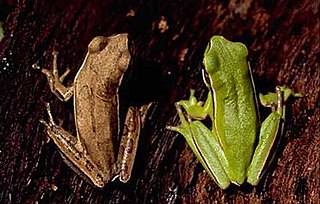
The Montevideo tree frog is a species of frog in the family Hylidae found in eastern, central, and northern Argentina, south-eastern Brazil, south-eastern Paraguay, and Uruguay. It is a common species occurring in open habitats in forests, grasslands, and flooded savannas. Breeding takes place in permanent ponds and flooded grasslands.
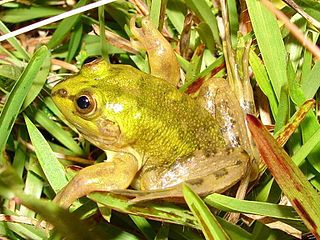
Pseudis cardosoi is a species of aquatic frog in the family Hylidae. It is endemic to southern Brazil and is known from the states of Rio Grande do Sul, Santa Catarina, and Paraná. The specific name cardosoi honors Adão José Cardoso, a Brazilian herpetologist.

Pseudis minuta is a species of aquatic frog in the family Hylidae. It is found in northeastern Argentina, Uruguay, and southern Brazil, and is likely to be found in southern Paraguay.
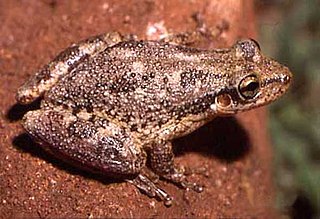
Scinax nasicus is a species of frog in the family Hylidae. It is found in Argentina, Bolivia, Brazil, Paraguay, and Uruguay. Its natural habitats are subtropical or tropical dry forests, moist savanna, temperate shrubland, subtropical or tropical dry shrubland, subtropical or tropical moist shrubland, subtropical or tropical high-altitude shrubland, temperate grassland, subtropical or tropical seasonally wet or flooded lowland grassland, freshwater lakes, intermittent freshwater lakes, freshwater marshes, arable land, pastureland, plantations, rural gardens, heavily degraded former forest, water storage areas, ponds, and canals and ditches.
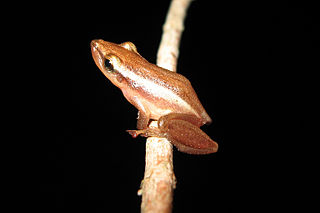
Scinax squalirostris is a species of frog in the family Hylidae. It is found in southeastern, southern and central Brazil, Uruguay, northeastern Argentina, southern Paraguay, and Bolivia. The nominal species might actually represent more than one species. Common names striped snouted treefrog and long-snouted treefrog have been coined for it.

Julianus uruguayus is a species of frog in the family Hylidae. It is found in Argentina, Brazil, and Uruguay. Its natural habitats are moist savanna, subtropical or tropical seasonally wet or flooded lowland grassland, freshwater marshes, and intermittent freshwater marshes. It is threatened by habitat loss.
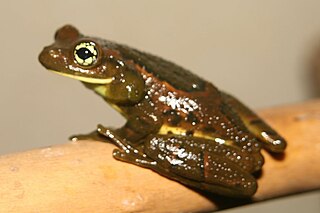
The Rio golden-eyed tree frog is a species of frog in the family Hylidae found in Argentina and Brazil. Its natural habitats are subtropical or tropical moist lowland forests, subtropical or tropical moist montane forests, and freshwater marshes. It is threatened by habitat loss.

Trachycephalus mesophaeus is a species of frog in the family Hylidae. It is endemic to eastern Brazil and occurs in the Atlantic Forest between Pernambuco and Rio Grande do Sul, extending inland to central Minas Gerais. It is found at elevations below 800 m (2,600 ft). Common name Porto Alegre golden-eyed treefrog has been coined for it, Porto Alegre being its type locality.
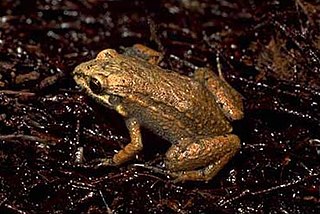
Adenomera araucaria is a species of frog in the family Leptodactylidae. It is endemic to southern Brazil, where it occurs in the southern part of the Serra Geral in the states of Santa Catarina and Rio Grande do Sul.
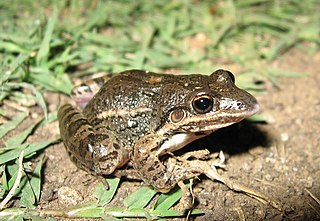
Leptodactylus latinasus is a species of frog in the family Leptodactylidae. It is found in the Gran Chaco of northern Argentina, Bolivia, and Paraguay and east and south to southern Brazil and Uruguay. Its natural habitats are subtropical or tropical grasslands near waterbodies. It tolerates anthropogenic disturbance well. It breeds in underground chambers. This abundant and adaptable species is not facing any important threats.

Physalaemus gracilis is a species of frog in the family Leptodactylidae. It is found in southern Brazil, Uruguay, and adjacent Argentina, and likely also in Paraguay. Its natural habitats are forest borders and Cerrado grasslands. It is an adaptable species that also occurs in heavily disturbed and polluted habitats. It breeds using foam nests in natural temporary pools. This abundant and widespread species is not facing major threats.

Proceratophrys bigibbosa is a species of frog in the family Odontophrynidae. It is found in the Misiones Province in the northeastern Argentina and in Rio Grande do Sul and Santa Catarina in southern Brazil; its range might extend into the adjacent Paraguay. Common names Peters' smooth horned frog and Cristina's smooth horned frog have been coined for it.
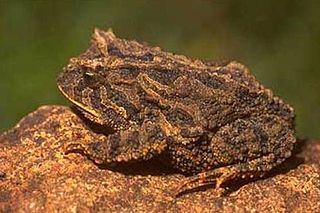
Proceratophrys brauni is a species of frog in the family Odontophrynidae. It is endemic to South Brazil and has been recorded in the Paraná, Santa Catarina, and Rio Grande do Sul states. The specific name brauni honors Pedro Canisio Braun, a Brazilian herpetologist. Common name horn toad has been coined for this species.

Chiasmocleis crucis is a species of frog in the family Microhylidae. It is endemic to Bahia in eastern Brazil. It is known from Camamu, its type locality, and from the Serra Bonita Private Reserve of Natural Heritage in Camacan/Pau Brasil. The specific name crucis honors Carlos Alberto Gonçalves da Cruz, a Brazilian herpetologist.

Phasmahyla spectabilis is a species of frog in the subfamily Phyllomedusinae. It is endemic to Brazil and known from the north-eastern Minas Gerais and adjacent southern Bahia. It occurs in fragments of Atlantic Forest at elevations of about 800 m (2,600 ft) above sea level.People have seen it as high as 850 meters above sea level.
Boana stellae is a frog in the family Hylidae, endemic to Brazil. Scientists know it from the type locality: between 200 and 600 meters above sea level on the Araucaria plateau in Rio Grande do Sul.



















